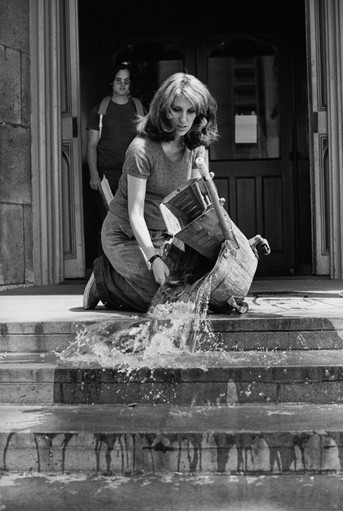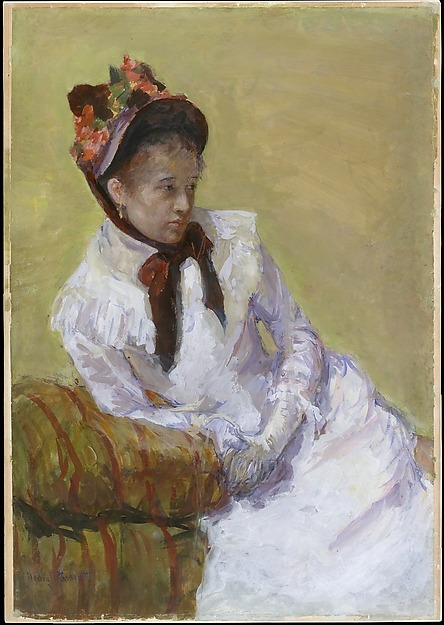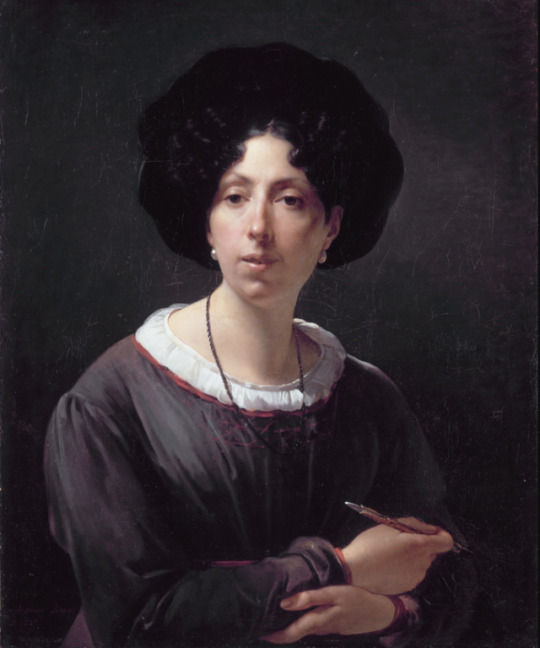Photo

Cindy Sherman, b. 1954
Madonna (Self-Portrait), 1975
Sherman is an American photographer who is well known for her conceptual portraits. She often turns the camera on herself, building a catalogue of the array of clichéd female ideals. In this portrait, she plays the role of Madonna. Although she is shrouded in a white veil like a religious figure, her long eyelashes, accentuated lips, and hair curls counteract the historical depiction. This could be a reference to the new woman of the ‘20′s whose liberated views on sexuality apposed the traditions of the time.
0 notes
Photo

Mierle Laderman Ukeles, b. 1939
Washing/ Tracks/ Maintenance: Inside, 1973
Mierle wrote in 1969 the Manifesto for Maintenance Art after the birth of her first child in 1968. Her art is about the everyday routines of life. These activities include child care, household work, and many others. Her most recent works synthesizes art and life with contexts of social, political. environmental, and feminist theory. She is the only artist to hold position as artist-in-residence at the New York Department of Sanitation. Washing/ Tracks/ Maintenance: Inside is a documentation photo of one of her performance works in New York.
0 notes
Photo

Frida Kahlo, 1907-1954
Self-Portrait with Small Monkey, 1945
Kahlo was a Mexican self-portrait artist who is still today admired as a feminist icon. She began painting after becoming severely injured in a bus accident. Her mother set an easel at her bed and during her recovery she completed her first self-portrait. In this particular portrait she is accompanied by her favourite animals, which substitute the children she was never able to have due to her injuries.
0 notes
Photo

Mary Cassatt, 1844-1926
Portrait of the Artist, 1878
The American painter who lived much of her life in France, befriended and followed a similar style to Edgar Degas and other Impressionist painters. She often created images of the social and private lives of women. She was determined to become a professional artist despite her families objections. She studied at the Pennsylvania Academy of Fine Arts, but was unhappy with the unfair treatment. For example, female students could not use live models. She moved to Paris, and despite women not being able to attend the Ecole des Beaux-Arts, she studied privately with masters from the school.
0 notes
Photo

Antoine Cécile Hortense Haudebort-Lescot, 1784-1845
Self-Portrait, 1825
Haudebourt-Lescot achieved a high degree of recognition in her lifetime. The Parisian painter travelled with her art instructor to Italy for eight years which supplied inspiration for her works that showed in her Paris Salon debut in 1810. Her fame received her several commissions from the French government for the Museum at Versailles along with many other accomplishments.
0 notes
Photo

Adélaide Labille-Guiard, 1749-1803
Self-Portrait with Two Pupils..., 1785
In 1783, Labille-Guiard was admitted to the French Académie Royale, when at the time the number of women artists eligible for membership was limited to four. She served as a lifelong champion for women’s rights and this work was considered to be propaganda arguing for the place of women in the academy.
0 notes
Photo

Judith Leyster 1609-1660
Self-Portrait, 1630
Dutch artist, Judith Leyster was one of only two women accepted as a master in Haarlem’s painter’s guild during the entire 17th century. The casual pose and brushwork of this self-portrait are considered very informal and portray women differently than many portraits at this time. This work served Leyster as a sort of self-promotion for her skills.
0 notes
Photo

Artemisia Gentileschi, 1593-1653
Self-Portrait as the Allegory of Painting (La Pittura), 1638- 1639
This work was completed during Gentileschi’s journey to England with her father on invitation by Charles I. In the self-portrait she is identifying herself as the female personification of Painting. Major accomplishments of the Baroque Italian painter include her having been patronned by Cosimo de’ Medici, the grand duke of Tuscany.
0 notes
Photo

Lavinia Fontana 1552-1614
Self- Portrait at the Clavicord with a Servant, 1577
This self portrait has been included to show the wealth obtained by Fontana through her art practice. The Italian painter was one of the most important portraitists in Bologna during the late 16th century. She was one of the first women to paint large, publicly commissioned figure paintings.
0 notes